Introduction To TensorFlow | Deep Learning Using TensorFlow | TensorFlow Tutorial | Edureka
- 1. Agenda ▪ Difference Between Machine Learning and Deep Learning ▪ What is Deep Learning? ▪ What is TensorFlow? ▪ TensorFlow Data Structures ▪ TensorFlow Use-Case
- 2. Agenda ▪ Difference Between Machine Learning and Deep Learning ▪ What is Deep Learning? ▪ What is TensorFlow? ▪ TensorFlow Data Structures ▪ TensorFlow Use-Case
- 3. Copyright © 2017, edureka and/or its affiliates. All rights reserved. Machine Learning vs Deep Learning Let’s see what are the differences between Machine Learning and Deep Learning
- 4. Copyright © 2017, edureka and/or its affiliates. All rights reserved. Machine Learning vs Deep Learning Machine Learning Deep Learning High performance on less data Low performance on less data Deep Learning Performance Machine Learning Performance
- 5. Copyright © 2017, edureka and/or its affiliates. All rights reserved. Machine Learning vs Deep Learning Machine Learning Deep Learning Can work on low end machines Requires high end machines
- 6. Copyright © 2017, edureka and/or its affiliates. All rights reserved. Machine Learning vs Deep Learning Machine Learning Deep Learning Features need to be hand-coded as per the domain and data type Tries to learn high-level features from data
- 7. Copyright © 2017, edureka and/or its affiliates. All rights reserved. What is Deep Learning? Now is the time to understand what exactly is Deep Learning?
- 8. Copyright © 2017, edureka and/or its affiliates. All rights reserved. What is Deep Learning? Input Layer Hidden Layer 1 Hidden Layer 2 Output Layer A collection of statistical machine learning techniques used to learn feature hierarchies often based on artificial neural networks
- 9. Copyright © 2017, edureka and/or its affiliates. All rights reserved. What are Tensors? Let’s see what are Tensors?
- 10. Copyright © 2017, edureka and/or its affiliates. All rights reserved. What Are Tensors? Tensors are the standard way of representing data in TensorFlow (deep learning). Tensors are multidimensional arrays, an extension of two-dimensional tables (matrices) to data with higher dimension. Tensor of dimension[1] Tensor of dimensions[2] Tensor of dimensions[3]
- 11. Copyright © 2017, edureka and/or its affiliates. All rights reserved. Tensors Rank Rank Math Entity Python Example 0 Scalar (magnitude only) s = 483 1 Vector (magnitude and direction) v = [1.1, 2.2, 3.3] 2 Matrix (table of numbers) m = [[1, 2, 3], [4, 5, 6], [7, 8, 9]] 3 3-Tensor (cube of numbers) t = [[[2], [4], [6]], [[8], [10], [12]], [[14], [16], [18 ]]] n n-Tensor (you get the idea) ....
- 12. Copyright © 2017, edureka and/or its affiliates. All rights reserved. Tensor Data Types In addition to dimensionality Tensors have different data types as well, you can assign any one of these data types to a Tensor
- 13. Copyright © 2017, edureka and/or its affiliates. All rights reserved. What Is TensorFlow? Now, is the time explore TensorFlow.
- 14. Copyright © 2017, edureka and/or its affiliates. All rights reserved. What Is TensorFlow? TensorFlow is a Python library used to implement deep networks. In TensorFlow, computation is approached as a dataflow graph. 3.2 -1.4 5.1 … -1.0 -2 2.4 … … … … … … … … … Tensor Flow Matmul W X Add Relu B Computational Graph Functions Tensors
- 15. Copyright © 2017, edureka and/or its affiliates. All rights reserved. TensorFlow Code-Basics Let’s understand the fundamentals of TensorFlow
- 16. Copyright © 2017, edureka and/or its affiliates. All rights reserved. TensorFlow Code-Basics TensorFlow core programs consists of two discrete sections: Building a computational graph Running a computational graph A computational graph is a series of TensorFlow operations arranged into a graph of nodes
- 17. Copyright © 2017, edureka and/or its affiliates. All rights reserved. TensorFlow Building And Running A Graph Building a computational graph Running a computational graph import tensorflow as tf node1 = tf.constant(3.0, tf.float32) node2 = tf.constant(4.0) print(node1, node2) Constant nodes sess = tf.Session() print(sess.run([node1, node2])) To actually evaluate the nodes, we must run the computational graph within a session. As the session encapsulates the control and state of the TensorFlow runtime.
- 18. Copyright © 2017, edureka and/or its affiliates. All rights reserved. Tensorflow Example a 5.0 Constimport tensorflow as tf # Build a graph a = tf.constant(5.0) b = tf.constant(6.0) c = a * b # Launch the graph in a session sess = tf.Session() # Evaluate the tensor 'C' print(sess.run(c)) Computational Graph
- 19. Copyright © 2017, edureka and/or its affiliates. All rights reserved. Tensorflow Example a b 5.0 6.0 Const Constimport tensorflow as tf # Build a graph a = tf.constant(5.0) b = tf.constant(6.0) c = a * b # Launch the graph in a session sess = tf.Session() # Evaluate the tensor 'C' print(sess.run(c)) Computational Graph
- 20. Copyright © 2017, edureka and/or its affiliates. All rights reserved. Tensorflow Example a b c 5.0 6.0 Const Mul Constimport tensorflow as tf # Build a graph a = tf.constant(5.0) b = tf.constant(6.0) c = a * b # Launch the graph in a session sess = tf.Session() # Evaluate the tensor 'C' print(sess.run(c)) Computational Graph
- 21. Copyright © 2017, edureka and/or its affiliates. All rights reserved. Tensorflow Example a b c 5.0 6.0 Const Mul 30.0 Constimport tensorflow as tf # Build a graph a = tf.constant(5.0) b = tf.constant(6.0) c = a * b # Launch the graph in a session sess = tf.Session() # Evaluate the tensor 'C' print(sess.run(c)) Running The Computational Graph
- 22. Copyright © 2017, edureka and/or its affiliates. All rights reserved. Graph Visualization
- 23. Copyright © 2017, edureka and/or its affiliates. All rights reserved. Graph Visualization For visualizing TensorFlow graphs, we use TensorBoard. The first argument when creating the FileWriter is an output directory name, which will be created if it doesn't exist. File_writer = tf.summary.FileWriter('log_simple_graph', sess.graph) TensorBoard runs as a local web app, on port 6006. (this is default port, “6006” is “ ” upside-down.)oo tensorboard --logdir = “path_to_the_graph” Execute this command in the cmd
- 24. Copyright © 2017, edureka and/or its affiliates. All rights reserved. Constants, Placeholders and Variables Let’s understand what are constants, placeholders and variables
- 25. Copyright © 2017, edureka and/or its affiliates. All rights reserved. Constant One type of a node is a constant. It takes no inputs, and it outputs a value it stores internally. import tensorflow as tf node1 = tf.constant(3.0, tf.float32) node2 = tf.constant(4.0) print(node1, node2) Constant nodes Constant Placeholder Variable
- 26. Copyright © 2017, edureka and/or its affiliates. All rights reserved. Constant One type of a node is a constant. It takes no inputs, and it outputs a value it stores internally. import tensorflow as tf node1 = tf.constant(3.0, tf.float32) node2 = tf.constant(4.0) print(node1, node2) Constant nodes Constant Placeholder Variable What if I want the graph to accept external inputs?
- 27. Copyright © 2017, edureka and/or its affiliates. All rights reserved. Placeholder Constant Placeholder Variable A graph can be parameterized to accept external inputs, known as placeholders. A placeholder is a promise to provide a value later.
- 28. Copyright © 2017, edureka and/or its affiliates. All rights reserved. Placeholder Constant Placeholder Variable A graph can be parameterized to accept external inputs, known as placeholders. A placeholder is a promise to provide a value later. How to modify the graph, if I want new output for the same input ?
- 29. Copyright © 2017, edureka and/or its affiliates. All rights reserved. Variable Constant Placeholder Variable To make the model trainable, we need to be able to modify the graph to get new outputs with the same input. Variables allow us to add trainable parameters to a graph
- 30. Copyright © 2017, edureka and/or its affiliates. All rights reserved. Let Us Now Create A Model
- 31. Copyright © 2017, edureka and/or its affiliates. All rights reserved. Simple Linear Model import tensorflow as tf W = tf.Variable([.3], tf.float32) b = tf.Variable([-.3], tf.float32) x = tf.placeholder(tf.float32) linear_model = W * x + b init = tf.global_variables_initializer() sess = tf.Session() sess.run(init) print(sess.run(linear_model, {x:[1,2,3,4]})) We've created a model, but we don't know how good it is yet
- 32. Copyright © 2017, edureka and/or its affiliates. All rights reserved. How To Increase The Efficiency Of The Model? Calculate the loss Model Update the Variables Repeat the process until the loss becomes very small A loss function measures how far apart the current model is from the provided data.
- 33. Copyright © 2017, edureka and/or its affiliates. All rights reserved. Calculating The Loss In order to understand how good the Model is, we should know the loss/error. To evaluate the model on training data, we need a y i.e. a placeholder to provide the desired values, and we need to write a loss function. We'll use a standard loss model for linear regression. (linear_model – y ) creates a vector where each element is the corresponding example's error delta. tf.square is used to square that error. tf.reduce_sum is used to sum all the squared error. y = tf.placeholder(tf.float32) squared_deltas = tf.square(linear_model - y) loss = tf.reduce_sum(squared_deltas) print(sess.run(loss, {x:[1,2,3,4], y:[0,-1,-2,-3]}))
- 34. Copyright © 2017, edureka and/or its affiliates. All rights reserved. Reducing The Loss Optimizer modifies each variable according to the magnitude of the derivative of loss with respect to that variable. Here we will use Gradient Descent Optimizer How Gradient Descent Actually Works? Let’s understand this with an analogy
- 35. Copyright © 2017, edureka and/or its affiliates. All rights reserved. Reducing The Loss • Suppose you are at the top of a mountain, and you have to reach a lake which is at the lowest point of the mountain (a.k.a valley). • A twist is that you are blindfolded and you have zero visibility to see where you are headed. So, what approach will you take to reach the lake?
- 36. Copyright © 2017, edureka and/or its affiliates. All rights reserved. Reducing The Loss • The best way is to check the ground near you and observe where the land tends to descend. • This will give an idea in what direction you should take your first step. If you follow the descending path, it is very likely you would reach the lake. Consider the length of the step as learning rate Consider the position of the hiker as weight Consider the process of climbing down the mountain as cost function/loss function
- 37. Copyright © 2017, edureka and/or its affiliates. All rights reserved. Reducing The Loss Global Cost/Loss Minimum Jmin(w) J(w) Let us understand the math behind Gradient Descent
- 38. Copyright © 2017, edureka and/or its affiliates. All rights reserved. Batch Gradient Descent The weights are updated incrementally after each epoch. The cost function J(⋅), the sum of squared errors (SSE), can be written as:
- 39. Copyright © 2017, edureka and/or its affiliates. All rights reserved. Batch Gradient Descent The weights are updated incrementally after each epoch. The cost function J(⋅), the sum of squared errors (SSE), can be written as: The magnitude and direction of the weight update is computed by taking a step in the opposite direction of the cost gradient
- 40. Copyright © 2017, edureka and/or its affiliates. All rights reserved. Batch Gradient Descent The weights are updated incrementally after each epoch. The cost function J(⋅), the sum of squared errors (SSE), can be written as: The magnitude and direction of the weight update is computed by taking a step in the opposite direction of the cost gradient The weights are then updated after each epoch via the following update rule:
- 41. Copyright © 2017, edureka and/or its affiliates. All rights reserved. Batch Gradient Descent The weights are updated incrementally after each epoch. The cost function J(⋅), the sum of squared errors (SSE), can be written as: The magnitude and direction of the weight update is computed by taking a step in the opposite direction of the cost gradient The weights are then updated after each epoch via the following update rule: Here, Δw is a vector that contains the weight updates of each weight coefficient w, which are computed as follows:
- 42. Copyright © 2017, edureka and/or its affiliates. All rights reserved. Reducing The Loss Suppose, we want to find the best parameters (W) for our learning algorithm. We can apply the same analogy and find the best possible values for that parameter. Consider the example below: optimizer = tf.train.GradientDescentOptimizer(0.01) train = optimizer.minimize(loss) sess.run(init) for i in range(1000): sess.run(train, {x:[1,2,3,4], y:[0,-1,-2,-3]}) print(sess.run([W, b]))
- 43. Copyright © 2017, edureka and/or its affiliates. All rights reserved. TensorFlow Use-Case
- 44. Copyright © 2017, edureka and/or its affiliates. All rights reserved. Long Short Term Memory Networks Use-Case We will feed a LSTM with correct sequences from the text of 3 symbols as inputs and 1 labeled symbol, eventually the neural network will learn to predict the next symbol correctly had a general LSTM cell Council Prediction label vs inputs LSTM cell with three inputs and 1 output.
- 45. Copyright © 2017, edureka and/or its affiliates. All rights reserved. Long Short Term Memory Networks Use-Case long ago , the mice had a general council to consider what measures they could take to outwit their common enemy , the cat . some said this , and some said that but at last a young mouse got up and said he had a proposal to make , which he thought would meet the case . you will all agree , said he , that our chief danger consists in the sly and treacherous manner in which the enemy approaches us . now , if we could receive some signal of her approach , we could easily escape from her . i venture , therefore , to propose that a small bell be procured , and attached by a ribbon round the neck of the cat . by this means we should always know when she was about , and could easily retire while she was in the neighborhood . this proposal met with general applause , until an old mouse got up and said that is all very well , but who is to bell the cat ? the mice looked at one another and nobody spoke . then the old mouse said it is easy to propose impossible remedies . How to train the network? A short story from Aesop’s Fables with 112 unique symbols
- 46. Copyright © 2017, edureka and/or its affiliates. All rights reserved. Long Short Term Memory Networks Use-Case A unique integer value is assigned to each symbol because LSTM inputs can only understand real numbers. 20 6 33 LSTM cell LSTM cell with three inputs and 1 output. had a general .01 .02 .6 .00 37 37 vs Council Council 112-element vector
- 47. Copyright © 2017, edureka and/or its affiliates. All rights reserved. Session In A Minute Machine Learning vs Deep Learning What is Deep Learning? What is TensorFlow? TensorFlow Code-Basics Simple Linear Model TensorFlow Use-Case
- 48. Copyright © 2017, edureka and/or its affiliates. All rights reserved.





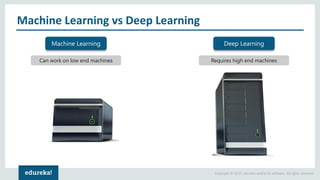

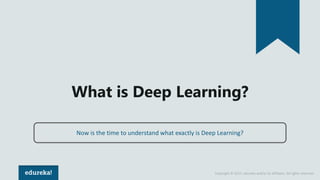


![Copyright © 2017, edureka and/or its affiliates. All rights reserved.
What Are Tensors?
Tensors are the standard way of representing data in TensorFlow (deep learning).
Tensors are multidimensional arrays, an extension of two-dimensional tables (matrices) to data
with higher dimension.
Tensor of
dimension[1]
Tensor of
dimensions[2]
Tensor of
dimensions[3]](https://image.slidesharecdn.com/tensorflowlivesession-171006113719/85/Introduction-To-TensorFlow-Deep-Learning-Using-TensorFlow-TensorFlow-Tutorial-Edureka-10-320.jpg)
![Copyright © 2017, edureka and/or its affiliates. All rights reserved.
Tensors Rank
Rank Math Entity Python Example
0 Scalar (magnitude
only)
s = 483
1 Vector (magnitude
and direction)
v = [1.1, 2.2, 3.3]
2 Matrix (table of
numbers)
m = [[1, 2, 3], [4, 5, 6], [7, 8, 9]]
3 3-Tensor (cube of
numbers)
t =
[[[2], [4], [6]], [[8], [10], [12]], [[14], [16], [18
]]]
n n-Tensor (you get
the idea)
....](https://image.slidesharecdn.com/tensorflowlivesession-171006113719/85/Introduction-To-TensorFlow-Deep-Learning-Using-TensorFlow-TensorFlow-Tutorial-Edureka-11-320.jpg)
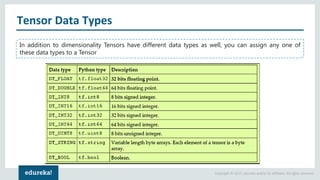




![Copyright © 2017, edureka and/or its affiliates. All rights reserved.
TensorFlow Building And Running A Graph
Building a computational graph Running a computational graph
import tensorflow as tf
node1 = tf.constant(3.0, tf.float32)
node2 = tf.constant(4.0)
print(node1, node2)
Constant nodes
sess = tf.Session()
print(sess.run([node1, node2]))
To actually evaluate the nodes, we must run
the computational graph within a session.
As the session encapsulates the control and
state of the TensorFlow runtime.](https://image.slidesharecdn.com/tensorflowlivesession-171006113719/85/Introduction-To-TensorFlow-Deep-Learning-Using-TensorFlow-TensorFlow-Tutorial-Edureka-17-320.jpg)


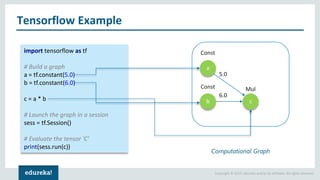
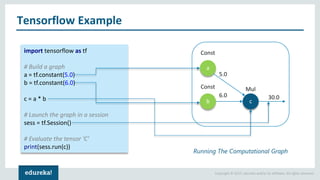







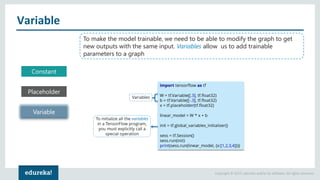

![Copyright © 2017, edureka and/or its affiliates. All rights reserved.
Simple Linear Model
import tensorflow as tf
W = tf.Variable([.3], tf.float32)
b = tf.Variable([-.3], tf.float32)
x = tf.placeholder(tf.float32)
linear_model = W * x + b
init = tf.global_variables_initializer()
sess = tf.Session()
sess.run(init)
print(sess.run(linear_model, {x:[1,2,3,4]}))
We've created a model, but we
don't know how good it is yet](https://image.slidesharecdn.com/tensorflowlivesession-171006113719/85/Introduction-To-TensorFlow-Deep-Learning-Using-TensorFlow-TensorFlow-Tutorial-Edureka-31-320.jpg)

![Copyright © 2017, edureka and/or its affiliates. All rights reserved.
Calculating The Loss
In order to understand how good the Model is, we should know the loss/error.
To evaluate the model on training data, we need a y i.e. a
placeholder to provide the desired values, and we need to
write a loss function.
We'll use a standard loss model for linear regression.
(linear_model – y ) creates a vector where each element is
the corresponding example's error delta.
tf.square is used to square that error.
tf.reduce_sum is used to sum all the squared error.
y = tf.placeholder(tf.float32)
squared_deltas = tf.square(linear_model - y)
loss = tf.reduce_sum(squared_deltas)
print(sess.run(loss, {x:[1,2,3,4], y:[0,-1,-2,-3]}))](https://image.slidesharecdn.com/tensorflowlivesession-171006113719/85/Introduction-To-TensorFlow-Deep-Learning-Using-TensorFlow-TensorFlow-Tutorial-Edureka-33-320.jpg)




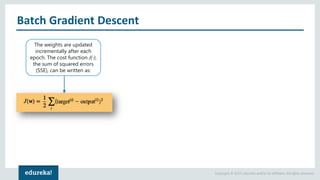



![Copyright © 2017, edureka and/or its affiliates. All rights reserved.
Reducing The Loss
Suppose, we want to find the best parameters (W) for our learning algorithm. We can apply the
same analogy and find the best possible values for that parameter. Consider the example below:
optimizer = tf.train.GradientDescentOptimizer(0.01)
train = optimizer.minimize(loss)
sess.run(init)
for i in range(1000):
sess.run(train, {x:[1,2,3,4], y:[0,-1,-2,-3]})
print(sess.run([W, b]))](https://image.slidesharecdn.com/tensorflowlivesession-171006113719/85/Introduction-To-TensorFlow-Deep-Learning-Using-TensorFlow-TensorFlow-Tutorial-Edureka-42-320.jpg)






